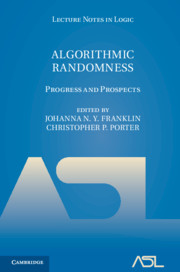Book contents
- Frontmatter
- Contents
- Preface
- 1 Key developments in algorithmic randomness
- 2 Algorithmic randomness in ergodic theory
- 3 Algorithmic randomness and constructive/computable measure theory
- 4 Algorithmic randomness and layerwise computability
- 5 Relativization in randomness
- 6 Aspects of Chaitin’s Omega
- 7 Biased algorithmic randomness
- 8 Higher randomness
- 9 Resource bounded randomness and its applications
- Index
1 - Key developments in algorithmic randomness
Published online by Cambridge University Press: 07 May 2020
- Frontmatter
- Contents
- Preface
- 1 Key developments in algorithmic randomness
- 2 Algorithmic randomness in ergodic theory
- 3 Algorithmic randomness and constructive/computable measure theory
- 4 Algorithmic randomness and layerwise computability
- 5 Relativization in randomness
- 6 Aspects of Chaitin’s Omega
- 7 Biased algorithmic randomness
- 8 Higher randomness
- 9 Resource bounded randomness and its applications
- Index
Summary
In this introductory survey, we provide an overview of the major developments of algorithmic randomness with an eye towards the historical development of the discipline. First we give a brief introduction to computability theory and the underlying mathematical concepts that later appear in the survey. Next we selectively cover four broad periods in which the primary developments in algorithmic randomness occurred: (1) the mid-1960s to mid-1970s, in which the main definitions of algorithmic randomness were laid out and the basic properties of random sequences were established; (2) the 1980s through the 1990s, which featured intermittent and important work from a handful of researchers; (3) the 2000s, during which there was an explosion of results as the discipline matured into a fully-fledged subbranch of computability theory; and (4) the early 2010s, in which ties between algorithmic randomness and other subfields of mathematics were discovered. The aim of this survey is to provide a point of entry for newcomers to the field and a useful reference for practitioners.
- Type
- Chapter
- Information
- Algorithmic RandomnessProgress and Prospects, pp. 1 - 39Publisher: Cambridge University PressPrint publication year: 2020
- 1
- Cited by

